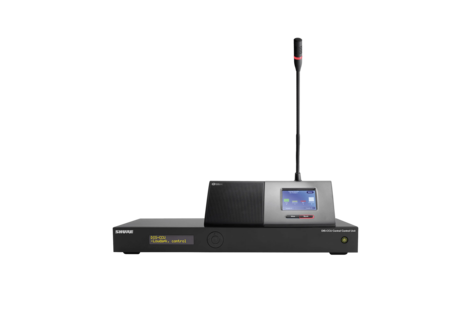High-security Courtroom At Stadelheim Jail Installs DIS DCS 6000

A new high-security courtroom was brought into service at Stadelheim Jail, Munich, Germany in September 2016 — one of the largest in Germany. The court holds up to 250 people and can be divided into two smaller courtrooms if required. A particular advantage of the new facility is that instead of having to be taken out of their cells and across Munich to the Central City Courts via dedicated prisoner transport vehicles, defendants can now simply be brought to the court via a secure, access-controlled entranceway and an underground passageway, remaining indoors the whole time.
The high-security courtroom is one of just two like it in the whole of Germany. Because significant trials often take place there, involving (for example) international terrorists, important figures in the world of organised crime, or state security matters, there can be a great deal of media interest. It was important that the testimony of those in the courtroom should be as intelligible, and of as high quality, as possible.
AV specialist MEDIA-tek GmbH, based in Bodenkirchen, to the north-east of Munich, was given the responsibility for the audio-visual side of the installation at the new courtroom. MEDIA-tek’s Managing Director Thomas Klug drew up an advanced plan for sound reinforcement with the assistance of various AV equipment manufacturers, with intelligibility at the forefront of the design.
Accordingly, all of the seats in the courtroom are fitted with DCS 6000 digital conferencing and interpreter units, which permit simultaneous translation into up to four different languages. The language of the court is always German, so the audio signals from defendants speaking other languages are first routed to an interpreter, translated simultaneously into German, and then fed into the sound reinforcement system. The behaviour of the conference system is always set up to reflect established practice in the judicial process — for example, judges speaking always take priority over everyone else, and the system is aware of the court personnel who may interrupt others, those who must register their wish to speak beforehand, and so on.
The number of seats for defendants, defence counsel and/or joint plaintiffs can change greatly depending on the trial, so the connections in courtroom conferencing systems have to be capable of reassignment and repatching to fit the requirements of the moment. In total, 100 hardware conferencing units are part of the Stadelheim installation, some free-standing on the courtroom desks, some more permanently built into the furniture. The output from the court interpreters is always available at every seat, and can even be sent via infra-red connections to additional wireless mobile receivers if required.
The audio conferencing system is fully integrated with the court’s video conferencing system, so no additional microphones or loudspeakers are required. The person speaking at any one time is recorded by seven cameras and appears on a large screen; additionally, this setup allows persons whose testimony is relevant to the trial to be included via video conferencing, even if they are located elsewhere. Those who may not be identified for legal reasons, or who have elected to remain anonymous, may make use of a separate video examination room. Pictures and audio signals from this room are processed in a computer before they are transmitted to the courtroom, so that the person testifying may not be recognised. All these technical features are controlled via specially programmed Crestron control surfaces, and the entire conferencing system is set up for each hearing and controlled throughout by trained court staff via a dedicated computer.
The DCS 6000 has proven itself to be an extremely flexible conferencing system at the Stadelheim courtroom, readily adaptable to the fluid requirements of the installation. The system is reliable in operation, and took account of all of the specifications given by the Munich Court of Appeal in respect of its legal and technical procedures. The system is also scalable and can be expanded without difficulty to accommodate large-scale trials with more co-plaintiffs or defendants. Custom loudspeakers were even developed and installed in the seating used by all the main parties in each court action, designed to reliably reproduce the sound of evidence being heard and also the audio picked up by the seat’s own conference unit, ensuring that all the spoken testimony heard in the court is as intelligible as possible.
Gear List
| Model Number | Quantity | Description | |
|---|---|---|---|

|
DCS 6000 | Digital conference system enables meetings of up to 3,800 users to be managed with complete control and reliability. |